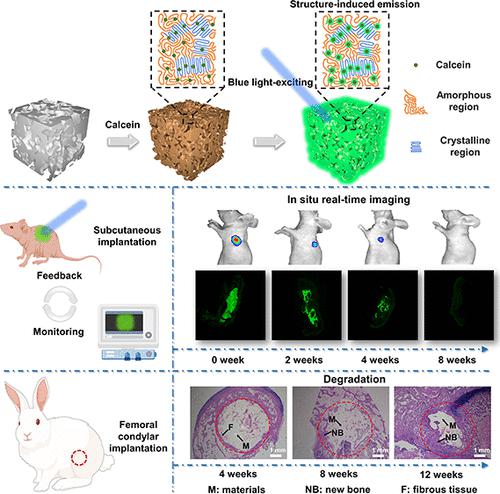当前位置:
X-MOL 学术
›
ACS Appl. Mater. Interfaces
›
论文详情
Our official English website, www.x-mol.net, welcomes your
feedback! (Note: you will need to create a separate account there.)
Biodegradable Polyurethane Scaffolds in Regeneration Therapy: Characterization and In Vivo Real-Time Degradation Monitoring by Grafted Fluorescent Tracer
ACS Applied Materials & Interfaces ( IF 8.3 ) Pub Date : 2023-12-19 , DOI: 10.1021/acsami.3c13187 Xiaoyu Lei 1 , Boyuan Yang 1 , Jie Chen 1 , Fang Yang 2 , Jiajing Tang 1 , Jihua Li 3 , Qing Zhao 1 , Jinzheng Zhang 1 , Jidong Li 1 , Yubao Li 1 , Yi Zuo 1
ACS Applied Materials & Interfaces ( IF 8.3 ) Pub Date : 2023-12-19 , DOI: 10.1021/acsami.3c13187 Xiaoyu Lei 1 , Boyuan Yang 1 , Jie Chen 1 , Fang Yang 2 , Jiajing Tang 1 , Jihua Li 3 , Qing Zhao 1 , Jinzheng Zhang 1 , Jidong Li 1 , Yubao Li 1 , Yi Zuo 1
Affiliation

|
There is an urgent need to assess material degradation in situ and in real time for their promising application in regeneration therapy. However, traditional monitoring methods in vitro cannot always profile the complicated behavior in vivo. This study designed and synthesized a new biodegradable polyurethane (PU-P) scaffold with polycaprolactone glycol, isophorone diisocyanate, and l-lysine ethyl ester dihydrochloride. To monitor the degradation process of PU-P, calcein was introduced into the backbone (PU-5) as a chromophore tracing in different sites of the body and undegradable fluorescent scaffold (CPU-5) as the control group. Both PU-P and PU-5 can be enzymatically degraded, and the degradation products are molecularly small and biosafe. Meanwhile, by virtue of calcein anchoring with urethane, polymer chains of PU-5 have maintained the conformational stability and extended the system conjugation, raising a structure-induced emission effect that successfully achieved a significant enhancement in the fluorescence intensity better than pristine calcein. Evidently, unlike the weak fluorescent response of CPU-5, PU-5 and its degradation can be clearly imaged and monitored in real time after implantation in the subcutaneous tissue of nude mice. Meanwhile, the in situ osteogeneration has also been promoted after the two degradable scaffolds have been implanted in the rabbit femoral condyles and degraded with time. To sum up, the strategy of underpinning tracers into degradable polymer chains provides a possible and effective way for real-time monitoring of the degradation process of implants in vivo.
中文翻译:

再生治疗中的可生物降解聚氨酯支架:通过接枝荧光示踪剂表征和体内实时降解监测
迫切需要对材料的原位降解进行实时评估,以了解其在再生治疗中的应用前景。然而,传统的体外监测方法不能总能描述体内复杂的行为。本研究以聚己内酯二醇、异佛尔酮二异氰酸酯和L-赖氨酸乙酯二盐酸盐设计并合成了一种新型可生物降解聚氨酯(PU-P)支架。为了监测PU-P的降解过程,将钙黄绿素引入骨架(PU-5)作为身体不同部位的发色团示踪,并将不可降解的荧光支架(CPU-5)作为对照组。 PU-P和PU-5均可被酶降解,且降解产物分子小且生物安全。同时,凭借钙黄绿素与氨基甲酸酯的锚定,PU-5的聚合物链保持了构象稳定性并延长了系统共轭性,提高了结构诱导发射效应,成功实现了优于原始钙黄绿素的荧光强度的显着增强。显然,与CPU-5的弱荧光响应不同,PU-5及其降解在植入裸鼠皮下组织后可以清晰地成像并实时监测。同时,两种可降解支架植入兔股骨髁并随时间降解后,也促进了原位成骨。综上所述,将示踪剂嵌入可降解聚合物链的策略为实时监测植入物体内降解过程提供了一种可能且有效的方法。
更新日期:2023-12-19
中文翻译:

再生治疗中的可生物降解聚氨酯支架:通过接枝荧光示踪剂表征和体内实时降解监测
迫切需要对材料的原位降解进行实时评估,以了解其在再生治疗中的应用前景。然而,传统的体外监测方法不能总能描述体内复杂的行为。本研究以聚己内酯二醇、异佛尔酮二异氰酸酯和L-赖氨酸乙酯二盐酸盐设计并合成了一种新型可生物降解聚氨酯(PU-P)支架。为了监测PU-P的降解过程,将钙黄绿素引入骨架(PU-5)作为身体不同部位的发色团示踪,并将不可降解的荧光支架(CPU-5)作为对照组。 PU-P和PU-5均可被酶降解,且降解产物分子小且生物安全。同时,凭借钙黄绿素与氨基甲酸酯的锚定,PU-5的聚合物链保持了构象稳定性并延长了系统共轭性,提高了结构诱导发射效应,成功实现了优于原始钙黄绿素的荧光强度的显着增强。显然,与CPU-5的弱荧光响应不同,PU-5及其降解在植入裸鼠皮下组织后可以清晰地成像并实时监测。同时,两种可降解支架植入兔股骨髁并随时间降解后,也促进了原位成骨。综上所述,将示踪剂嵌入可降解聚合物链的策略为实时监测植入物体内降解过程提供了一种可能且有效的方法。


















































 京公网安备 11010802027423号
京公网安备 11010802027423号